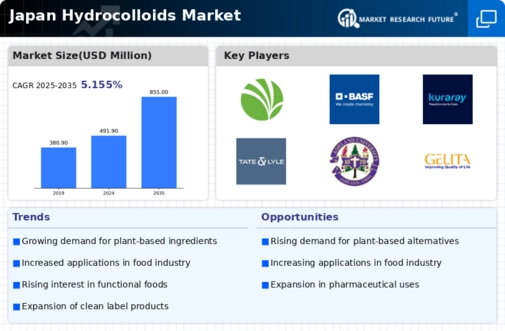Increasing Health Consciousness
The rising health consciousness among consumers in Japan is a pivotal driver for the hydrocolloids market. As individuals become more aware of the nutritional value of their food, there is a growing preference for products that contain natural and functional ingredients. Hydrocolloids, known for their thickening, gelling, and stabilizing properties, are increasingly utilized in health-oriented food products. This trend is reflected in the market data, which indicates that the demand for hydrocolloids in health foods has surged by approximately 15% over the past year. The hydrocolloids market is thus adapting to meet these evolving consumer preferences, leading to innovations that align with health trends.
Expansion of Food Processing Industry
The expansion of the food processing industry in Japan significantly influences the hydrocolloids market. As the food sector grows, the need for stabilizers, thickeners, and emulsifiers becomes more pronounced. Hydrocolloids play a crucial role in enhancing the texture and shelf-life of processed foods. Recent statistics suggest that the food processing industry in Japan is projected to grow at a CAGR of 4% through 2026, which directly correlates with the increasing utilization of hydrocolloids. This growth presents opportunities for the hydrocolloids market to innovate and provide tailored solutions that meet the specific needs of food manufacturers.
Rising Popularity of Plant-Based Foods
The rising popularity of plant-based foods in Japan is a significant driver for the hydrocolloids market. As consumers increasingly seek alternatives to animal-based products, the demand for plant-based ingredients, including hydrocolloids, is on the rise. Hydrocolloids derived from plants, such as agar and carrageenan, are particularly favored for their functional properties in vegan and vegetarian products. Market analysis indicates that the plant-based food sector is expected to grow by 20% in the next five years, which will likely bolster the hydrocolloids market. This trend reflects a broader shift towards sustainable eating habits, further driving innovation in hydrocolloid applications.
Regulatory Support for Clean Label Initiatives
Regulatory support for clean label initiatives in Japan is fostering growth in the hydrocolloids market. As consumers demand transparency in food labeling, regulations are evolving to support the use of natural ingredients. Hydrocolloids, often derived from natural sources, align well with these clean label trends. The Japanese government has been promoting initiatives that encourage the use of clean label ingredients, which is likely to enhance consumer trust and drive sales. The hydrocolloids market is positioned to capitalize on this regulatory environment, as manufacturers seek to comply with clean label standards while meeting consumer expectations for quality and safety.
Technological Advancements in Extraction Methods
Technological advancements in extraction methods for hydrocolloids are reshaping the landscape of the hydrocolloids market. Innovations in extraction techniques, such as enzymatic and ultrasonic methods, enhance the yield and quality of hydrocolloids derived from natural sources. This is particularly relevant in Japan, where there is a strong emphasis on quality and purity in food products. The hydrocolloids market is likely to benefit from these advancements, as they enable manufacturers to produce high-quality hydrocolloids that meet stringent regulatory standards. Furthermore, these technologies may reduce production costs, making hydrocolloids more accessible to a broader range of food applications.






















Leave a Comment